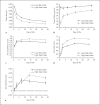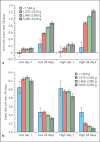Birthweight and Environmental Conditions Impact Skin Barrier Adaptation in Neonates Receiving Natural Oil Massage
- PMID: 33791313
- PMCID: PMC7991291
- DOI: 10.1159/000512274
Birthweight and Environmental Conditions Impact Skin Barrier Adaptation in Neonates Receiving Natural Oil Massage
Abstract
Introduction: Skin interventions have been implemented to reduce neonatal mortality, demonstrating the skin's role in neonatal innate immunity. We examined the impact of birthweight and environmental conditions on skin integrity in infants receiving oil massage in rural Nepal.
Methods: In a community-based cluster randomized controlled trial, 991 premature and full-term infants were grouped by birthweight as: (1) 920-1,560 g, (2) 1,570-2,450 g, (3) 2,460-2,990 g, and (4) 3,000-4,050 g and by high or low heat index (HI). Skin integrity was measured as erythema, rash, dryness, pH, protein concentration, and transepidermal water loss (TEWL).
Results: Skin pH was higher for the smallest (group 1) than the largest infants (group 4) and higher for group 2 than 3 and 4. Arm and leg rash differed for all 4 groups, with the least amount of rash for the smallest babies. Erythema was lower for group 1 than all others. The lower day 1 values for pH, TEWL and protein at high versus low HI remained lower over 28 days. The pH reduction was faster at high HI. Erythema (arm, leg) was more severe at high HI. Rash severity was greater at high HI for arms and legs every day.
Conclusions: Birthweight influenced the skin response to oil massage. The smallest infants had the lowermost skin irritation, suggesting diminished ability to mount an inflammatory response. High HI may be protective for premature infants in low resource settings.
Keywords: Environmental conditions; Infant; Massage; Neonate; Premature infant; Skin barrier; Skin integrity; Skin pH; Stratum corneum; Topical natural oil; Transepidermal water loss.
Copyright © 2021 by S. Karger AG, Basel.
Conflict of interest statement
The authors have no financial relationships or potential conflicts of interest to disclose.
Figures



References
-
- Darmstadt GL, Saha SK, Ahmed AS, Chowdhury MA, Law PA, Ahmed S, et al. Effect of topical treatment with skin barrier-enhancing emollients on nosocomial infections in preterm infants in Bangladesh: a randomised controlled trial. Lancet. 2005 Mar;365((9464)):1039–45. - PubMed
-
- UNICEF. WHO, Bank TW. Division UNP . In: Levels and Trends in Child Mortality. Report 2015. editor. IGME TI-aGfCMEU, editor. New York, USA: UNICEF; 2015.
LinkOut - more resources
Full Text Sources
Other Literature Sources

